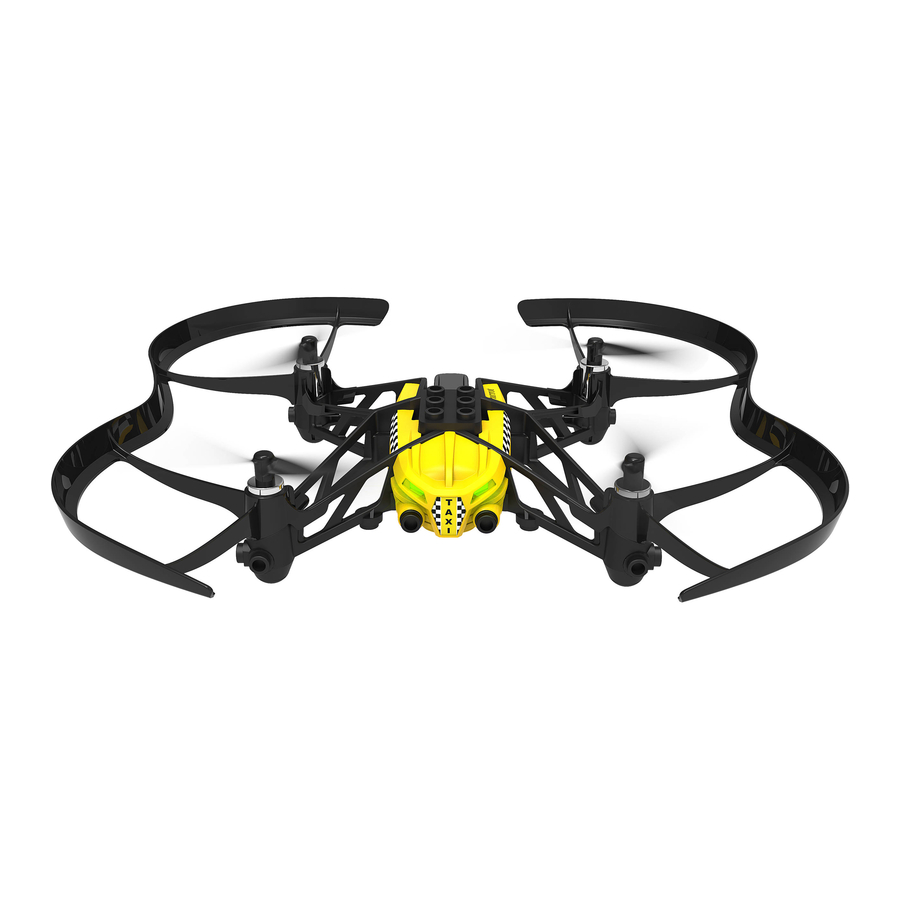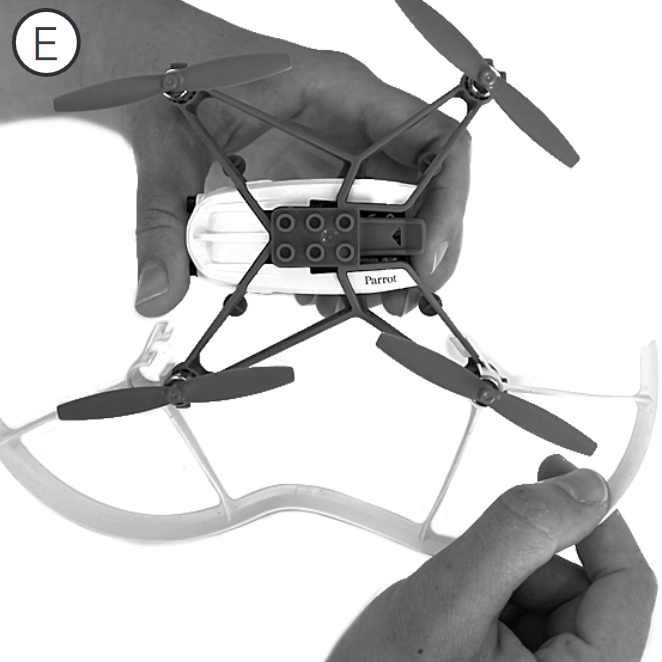Advertisement

QUICK START GUIDE
This MiniDrone quick start guide gives you just the main instructions. You will find full documentation on our Website www.parrot.com/uk/support/airborne-cargo-drone.
Charging the battery
- Insert the battery into the appropriate comparment (photos A and B).
![Parrot Minidrones - AIRBORNE CARGO - Charging the battery - Insert the battery into the appropriate comparment - Step 1 Charging the battery - Insert the battery into the appropriate comparment - Step 1]()
![Parrot Minidrones - AIRBORNE CARGO - Charging the battery - Insert the battery into the appropriate comparment - Step 2 Charging the battery - Insert the battery into the appropriate comparment - Step 2]()
- Connect the MiniDrone (photos C and D):
![Parrot Minidrones - AIRBORNE CARGO - Charging the battery - Connect the MiniDrone - Step 1 Charging the battery - Connect the MiniDrone - Step 1]()
![Parrot Minidrones - AIRBORNE CARGO - Charging the battery - Connect the MiniDrone - Step 2 Charging the battery - Connect the MiniDrone - Step 2]()
- To a 2.4 A minimum charger (not provided).
The charging time is approximately 25 minutes. - To your computer using the USB. The charging time is approximately 1 hour and 30 minutes.
- To a 2.4 A minimum charger (not provided).
To remove the battery, lift the black part located above the battery and slide it backwards.
Downloading the application
Connect to the App StoreSM or on Google PlayTM and download the FreeFlight3 app free of charge.
Attaching the Shields
The shields protect the MiniDrone in the event of a collision with another object. Clip the shields under each propeller (photo E).

Switching on the MiniDrone
The On/Off button is located under the MiniDrone (photo F).

Connecting a Smartphone
You need a smartphone or a tablet which supports Bluetooth® 4.0 to be able to use the MiniDrone. Check the compatibility with your smartphone on the support page of our website www.parrot.com/uk/compatibility.
Activate the Bluetooth® function on your smartphone.
- Launch the FreeFlight3 app. The MiniDrone will automatically connect to your smartphone.
Flying
Press on Take Off for the MiniDrone to take off.
Press on the right joystick while tilting your smartphone forwards or backwards to fly your MiniDrone forwards or backwards, and towards the left or right to make it turn left or right.
Press on  or
or  to rotate the MiniDrone to the right or left.
to rotate the MiniDrone to the right or left.
Press on  or
or  to fly the MiniDrone upwards or downards.
to fly the MiniDrone upwards or downards.
Go to www.parrot.com/uk/support/airborne-cargodrone to watch the piloting tutorials for the MiniDrone.
Taking a picture
Press on ![]() to take a picture.
to take a picture.
GENERAL INFORMATION
Accessories and spare parts
Accessories and spare parts are available from your Parrot retailer or from our website store.parrot.com.
Precautions for use and maintenance
The MiniDrone is not suitable for children under 14 years of age.
The MiniDrone is a model aircraft designed for recreational and leisure purposes. The pilot must always maintain direct visual contact with the MiniDrone and monitor its trajectory. The MiniDrone must be used in accordance with the civil aviation rules in your country. You should only use it in open spaces so you are always able to ensure the safety of person, animals and property. There are some public places (stations, airports etc.) and roads where you may not be permitted to use your MiniDrone.
To use your MiniDrone indoors, use the shields to protect the MiniDrone in case it collides with another object.
In flight, the propellers of the MiniDrone can cause injury to people and property. Don't touch the MiniDrone while it's flying! Wait until the propellers have completely stopped before handling the MiniDrone.
Only use accessories specified by the manufacturer.
If sand or dust gets into the MiniDrone, irreversible damage may be caused and it will not be able to operate properly.
Do not use the MiniDrone in adverse meteorological conditions (rain, strong wind, snow) or in poor visibility conditions (at night).
Keep the MiniDrone away from high voltage power lines, buildings or any other potentially dangerous areas.
Do not use this device close to any liquid substances. Do not land the MiniDrone on water nor on any damp surface, it might cause irreversible damage.
Avoid subjecting the MiniDrone to any sudden significant changes in altitude.
Do not leave the MiniDrone in direct sunlight.
Warranty
For the warranty conditions please refer to the retailer's General Conditions of Sale where you purchased your MiniDrone.
Recycling this product

The symbol on this product and on its literature shows that at the end of its life, it is not to be disposed of with household waste. The uncontrolled disposal of waste is harmful to the environment: please separate this from other types of waste and dispose of responsibly. Private individuals are invited to contact the retailer who sold them the product or to ask advice from their local authority to find out how and where it can be recycled.
Declaration of conformity
Parrot SA, 174 quai de Jemmapes, 75010 Paris, France, declares under their sole responsibility that the product described in this user guide complies with EN 301489-17, EN300328, EN71-1, EN71-2, EN62115 technical standards following the provision of the Radio Equipment, Telecommunication Equipment directive (1999/5/ EC R&TTE), and of the General Safety directive (2001/95/EC).
The Declaration of Conformity is available on our website: www.parrot.com/uk/ce/?airborne-cargo-drone
Registered trademarks
Parrot, Parrot MiniDrones and the Parrot logo are trademarks of PARROT SA.
App Store is a service mark of Apple Inc.
Google Play is a trademark of Google Inc.
The Bluetooth® word mark and logos are registered trademarks owned by Bluetooth SIG, Inc. and any use of such marks by Parrot SA is under license.
All other trademarks mentioned in this guide are protected and are the property of their respective owners.
FCC and IC compliance certification
This equipment has been tested and found to comply with the limits for a Class B Digital Device, pursuant to Part 15 of the FCC Rules / with Industry Canada Licence-exempt RSS standard(s). These limits are designed to provide reasonable protection against harmful interference in a residential installation. This equipment generates, uses and can radiate radio frequency energy and, if not installed and used in accordance with the instructions, may cause harmful interference to radio communications. However, there is no guarantee that interference will not occur in a particular installation. If this equipment does cause harmful interference to radio or television reception, which can be determined by turning the equipment off and on, the user is encouraged to try to correct the interference by one or more of the following measures:
- Reorient or relocate the receiving antenna.
- Increase the distance between the equipment and receiver.
- Connect the equipment to an outlet on a circuit different from that to which the receiver is connected.
- Consult the dealer or an experienced radio/TV technician for help.
This equipment complies with Part 15 of the FCC Rules / with Industry Canada Licence-exempt RSS standard(s).
Operation is subject to the following two conditions:
This equipment may not cause harmful interference. This equipment must accept any interference received, including interference that may cause undesired operation.
Modifications not authorized by the manufacturer may void the user's authority to operate this device.
Exposure to radio frequency radiation
The installer of this radio equipment must ensure that the antenna is located or pointed such that it does not permit RF field in excess of Health Canada limits for the general population; consult Safety Code 6, obtainable from Health Canada's website at www.hc-sc.gc.ca.
The user is required to apply for localized Radiocommunication Station Licence in Singapore. Applicants can apply online for the localized Radio-communication Station Licence through www.business.gov.sg/licences.
Notice regarding the right to privacy
Recording and circulating the image of a person without their authorisation could constitute an infringement of their image and privacy rights and incur your liability. Ask for authorisation before filming individuals, particularly if you want to keep your recordings and/or circulate them on the Internet. Do not circulate any degrading images or which could undermine the reputation or dignity of an individual.
Battery
Failure to comply with instructions may cause permanent damage to the battery, its environment and may cause injury. Always use a LiPo battery charger. Never charge via a discharge lead. Never trickle charge or below 2.5 V. Never allow the battery temperature to exceed 60°C (140°F). Never disassemble or modify the wiring in the battery pack or puncture the battery cell. Never place the battery on top of combustible materials or leave it unattended during charging. Always charge in a fireproof location. Always make sure that the charger output voltage corresponds to the battery voltage. Always keep out of the reach of children. Incorrect use of the battery can cause fires, explosions or other damage.
Tutorials, FAQS, spare parts, support: parrot.com/help/airborne-cargo

The battery terminals should not be allowed to short-circuit. The product should be connected only to class II appliances which display the symbol.


VideosParrot Minidrones - Airborne - Tutorial Video #1: Setup
Parrot Minidrones - Airborne - Tutorial Video #2: Piloting
Parrot Minidrones - Airborne - Tutorial Video #3: Tips & Tricks
Documents / Resources
References
Welcome to the Health Canada Web site | Bienvenue au site Web de Sant Canada
![parrot.com]() Parrot | European leader in professional drones
Parrot | European leader in professional drones
Download manual
Here you can download full pdf version of manual, it may contain additional safety instructions, warranty information, FCC rules, etc.
Download Parrot Minidrones AIRBORNE CARGO DRONE Quick Start Guide
Advertisement









Need help?
Do you have a question about the AIRBORNE CARGO and is the answer not in the manual?
Questions and answers